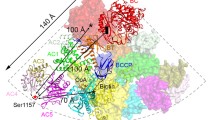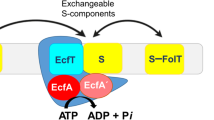Abstract
Acetyl-coenzyme A carboxylases (ACCs) is the first committed enzyme of fatty acid synthesis pathway. The inhibition of ACC is thought to be beneficial not only for diseases related to metabolism, such as type-2 diabetes, but also for infectious disease like bacterial infection disease. Soraphen A, a potent allosteric inhibitor of BC domain of yeast ACC, exhibit lower binding affinities to several yeast ACC mutants and the corresponding drug resistance mechanisms are still unknown. We report here a theoretical study of binding of soraphen A to wild type and yeast ACC mutants (including F510I, N485G, I69E, E477R, and K73R) via molecular dynamic simulation and molecular mechanics/generalized Born surface area free energy calculations methods. The calculated binding free energies of soraphen A to yeast ACC mutants are weaker than to wild type, which is highly consistent with the experimental results. The mutant F510I weakens the binding affinity of soraphen A to yeast ACC mainly by decreasing the van der Waals contributions, while the weaker binding affinities of Soraphen A to other yeast ACC mutants including N485G, I69E, E477R, and K73R are largely attributed to the decreased net electrostatic (ΔEele + ΔGGB) interactions. Our simulation results could provide important insights for the development of more potent ACC inhibitors.








Similar content being viewed by others
References
Corominasfaja B, Cuyàs E, Gumuzio J, Boschbarrera J, Leis O, Martin ÁG, Menendez JA (2014) Chemical inhibition of acetyl-CoA carboxylase suppresses self-renewal growth of cancer stem cells. Oncotarget 5(18):8306–8316
Huang T, Sun J, Wang Q, Gao J, Liu Y (2015) Synthesis, biological evaluation and molecular docking studies of piperidinylpiperidines and spirochromanones possessing quinoline moieties as acetyl-CoA carboxylase inhibitors. Molecules 20(9):16221–16234
Harriman G, Greenwood J, Bhat S, Huang X, Wang R, Paul D, Tong L, Saha AK, Westlin WF, Kapeller R (2016) Acetyl-CoA carboxylase inhibition by ND-630 reduces hepatic steatosis, improves insulin sensitivity, and modulates dyslipidemia in rats. Proc Natl Acad Sci USA 113(13):E1796
Svensson RU, Parker SJ, Eichner LJ, Kolar MJ, Wallace M, Brun SN, Lombardo PS, Nostrand JLV, Hutchins A, Vera L (2016) Inhibition of acetyl-CoA carboxylase suppresses fatty acid synthesis and tumor growth of non-small-cell lung cancer in preclinical models. Nat Med 22(10):1108
Saggerson D (2008) Malonyl-CoA, a key signaling molecule in mammalian cells. Annu Rev Nutr 28:253–272. https://doi.org/10.1146/annurev.nutr.28.061807.155434
Abu-Elheiga L, Matzuk MM, Abo-Hashema KA, Wakil SJ (2001) Continuous fatty acid oxidation and reduced fat storage in mice lacking acetyl-CoA carboxylase 2. Science 291(5513):2613–2616. https://doi.org/10.1126/science.1056843
Lenhard JM, Gottschalk WK (2002) Preclinical developments in type 2 diabetes. Adv Drug Deliv Rev 54(9):1199–1212
Shen Y, Volrath SL, Weatherly SC, Elich TD, Tong L (2004) A mechanism for the potent inhibition of eukaryotic acetyl-coenzyme A carboxylase by soraphen A, a macrocyclic polyketide natural product. Mol Cell 16(6):881–891. https://doi.org/10.1016/j.molcel.2004.11.034
Miller JR, Dunham S, Mochalkin I, Banotai C, Bowman M, Buist S, Dunkle B, Hanna D, Harwood HJ, Huband MD, Karnovsky A, Kuhn M, Limberakis C, Liu JY, Mehrens S, Mueller WT, Narasimhan L, Ogden A, Ohren J, Prasad JV, Shelly JA, Skerlos L, Sulavik M, Thomas VH, VanderRoest S, Wang L, Wang Z, Whitton A, Zhu T, Stover CK (2009) A class of selective antibacterials derived from a protein kinase inhibitor pharmacophore. Proc Natl Acad Sci USA 106(6):1737–1742. https://doi.org/10.1073/pnas.0811275106
Mochalkin I, Miller JR, Narasimhan L, Thanabal V, Erdman P, Cox PB, Prasad JV, Lightle S, Huband MD, Stover CK (2009) Discovery of antibacterial biotin carboxylase inhibitors by virtual screening and fragment-based approaches. ACS Chem Biol 4(6):473–483. https://doi.org/10.1021/cb9000102
Cheng CC, Shipps GW Jr, Yang Z, Sun B, Kawahata N, Soucy KA, Soriano A, Orth P, Xiao L, Mann P, Black T (2009) Discovery and optimization of antibacterial AccC inhibitors. Bioorg Med Chem Lett 19(23):6507–6514. https://doi.org/10.1016/j.bmcl.2009.10.057
Polyak SW, Abell AD, Wilce MC, Zhang L, Booker GW (2012) Structure, function and selective inhibition of bacterial acetyl-coa carboxylase. Appl Microbiol Biotechnol 93(3):983–992. https://doi.org/10.1007/s00253-011-3796-z
Gao J, Sun J, Wang T, Sheng S, Huang T (2017) Combined 3D-QSAR modeling and molecular docking study on spiro-derivatives as inhibitors of acetyl-CoA carboxylase. Med Chem Res 26(2):361–371
Gerth K, Bedorf N, Irschik H, Hofle G, Reichenbach H (1994) The soraphens—a family of novel antifungal compounds from Sorangium-cellulosum (Myxobacteria).1. Soraphen a(1-alpha)—fermentation, isolation, biological properties. J Antibiot 47(1):23–31
Vahlensieck HF, Pridzun L, Reichenbach H, Hinnen A (1994) Identification of the yeast ACC1 gene product (acetyl-CoA carboxylase) as the target of the polyketide fungicide soraphen A. Curr Genet 25(2):95–100
Weatherly SC, Volrath SL, Elich TD (2004) Expression and characterization of recombinant fungal acetyl-CoA carboxylase and isolation of a soraphen-binding domain. Biochem J 380(Pt 1):105–110. https://doi.org/10.1042/BJ20031960
Case DA, Cheatham TE 3rd, Darden T, Gohlke H, Luo R, Merz KM Jr, Onufriev A, Simmerling C, Wang B, Woods RJ (2005) The Amber biomolecular simulation programs. J Comput Chem 26(16):1668–1688. https://doi.org/10.1002/jcc.20290
Frisch MJ, Trucks GW, Schlegel HB, Scuseria GE, Robb MA, Cheeseman JR, Scalmani G, Barone V, Petersson GA, Nakatsuji H, Li X, Caricato M, Marenich A, Bloino J, Janesko BG, Gomperts R, Mennucci B, Hratchian HP, Ortiz JV, Izmaylov AF, Sonnenberg JL, Williams-Young D, Ding F, Lipparini F, Egidi F, Goings J, Peng B, Petrone A, Henderson T, Ranasinghe D, Zakrzewski VG, Gao J, Rega N, Zheng G, Liang W, Hada M, Ehara M, Toyota K, Fukuda R, Hasegawa J, Ishida M, Nakajima T, Honda Y, Kitao O, Nakai H, Vreven T, Throssell K, Montgomery JA Jr, Peralta JE, Ogliaro F, Bearpark M, Heyd JJ, Brothers E, Kudin KN, Staroverov VN, Keith T, Kobayashi R, Normand J, Raghavachari K, Rendell A, Burant JC, Iyengar SS, Tomasi J, Cossi M, Millam JM, Klene M, Adamo C, Cammi R, Ochterski JW, Martin RL, Morokuma K, Farkas O, Foresman JB, Fox DJ (2016) Gaussian 09 RA. Gaussian, Inc., Wallingford
Wang J, Wang W, Kollman PA, Case DA (2006) Automatic atom type and bond type perception in molecular mechanical calculations. J Mol Graph Model 25(2):247–260. https://doi.org/10.1016/j.jmgm.2005.12.005
Duan Y, Wu C, Chowdhury S, Lee MC, Xiong G, Zhang W, Yang R, Cieplak P, Luo R, Lee T, Caldwell J, Wang J, Kollman P (2003) A point-charge force field for molecular mechanics simulations of proteins based on condensed-phase quantum mechanical calculations. J Comput Chem 24(16):1999–2012. https://doi.org/10.1002/jcc.10349
Wang J, Wolf RM, Caldwell JW, Kollman PA, Case DA (2004) Development and testing of a general amber force field. J Comput Chem 25(9):1157–1174. https://doi.org/10.1002/jcc.20035
Jorgensen WL, Chandrasekhar J, Madura JD, Impey RW, Klein ML (1983) Comparison of simple potential functions for simulating liquid water. J Chem Phys 79(2):926–935
Ryckaert JP, Ciccotti G, Berendsen HJC (1977) Numerical integration of the cartesian equations of motion of a system with constraints: molecular dynamics of n-alkanes. J Comput Phys 23(3):327–341
Darden T, York D, Pedersen L (1993) Particle mesh Ewald: an N⋅log(N) method for Ewald sums in large systems. J Chem Phys 98(12):10089–10092. https://doi.org/10.1063/1.464397
Wang J, Hou T, Xu X (2006) Recent advances in free energy calculations with a combination of molecular mechanics and continuum models. Curr Comput 2(3):287–306
Kollman PA, Massova I, Reyes C, Kuhn B, Huo S, Chong L, Lee M, Lee T, Duan Y, Wang W, Donini O, Cieplak P, Srinivasan J, Case DA, Cheatham TE (2000) Calculating structures and free energies of complex molecules: combining molecular mechanics and continuum models. Acc Chem Res 33(12):889–897
Onufriev A, Bashford D, Case DA (2004) Exploring protein native states and large-scale conformational changes with a modified generalized born model. Proteins 55(2):383–394
Weiser J, Shenkin PS, Still WC (1999) Approximate atomic surfaces from linear combinations of pairwise overlaps (LCPO). J Comput Chem 20(2):217–230
Hou T, Wang J, Li Y, Wang W (2010) Assessing the performance of the MM/PBSA and MM/GBSA Methods. 1. The accuracy of binding free energy calculations based on molecular dynamics simulations. J Chem Inf Model 51(1):69–82. https://doi.org/10.1021/ci100275a
Gao J, Cui W, Du Y, Ji M (2013) Insight into the molecular mechanism about lowered dihydrofolate binding affinity to dihydrofolate reductase-like 1 (DHFRL1). J Mol Model 19(12):5187–5198. https://doi.org/10.1007/s00894-013-2018-2
Gohlke H, Kiel C, Case DA (2003) Insights into protein-protein binding by binding free energy calculation and free energy decomposition for the Ras-Raf and Ras-RalGDS complexes. J Mol Biol 330(4):891–913
Onufriev A, Bashford D, Case DA (2004) Exploring protein native states and large-scale conformational changes with a modified generalized born model. Proteins 55(2):383–394. https://doi.org/10.1002/prot.20033
Delano WL (2002) The PyMOL molecular graphics system. DeLano Scientific, San Carlos
Funding
This study was funded by National Natural Science Foundation of China (NSFC No. 21708033), China Postdoctoral Science Foundation funded project (Grants No. 2017M611916), Natural Science Foundation of Jiangsu Province (Grants No. BK20171184), Scientific Research Foundation for Talented Scholars of Xuzhou Medical College (Grant No. D2014008), and Science and Technology project of Xuzhou (Grant No. KC16SG249).
Author information
Authors and Affiliations
Corresponding authors
Ethics declarations
Conflict of interest
The authors declare that they have no conflict of interest.
Electronic supplementary material
Below is the link to the electronic supplementary material.
Rights and permissions
About this article
Cite this article
Gao, J., Liang, L., Chen, Q. et al. Insight into the molecular mechanism of yeast acetyl-coenzyme A carboxylase mutants F510I, N485G, I69E, E477R, and K73R resistant to soraphen A. J Comput Aided Mol Des 32, 547–557 (2018). https://doi.org/10.1007/s10822-018-0108-z
Received:
Accepted:
Published:
Issue Date:
DOI: https://doi.org/10.1007/s10822-018-0108-z




